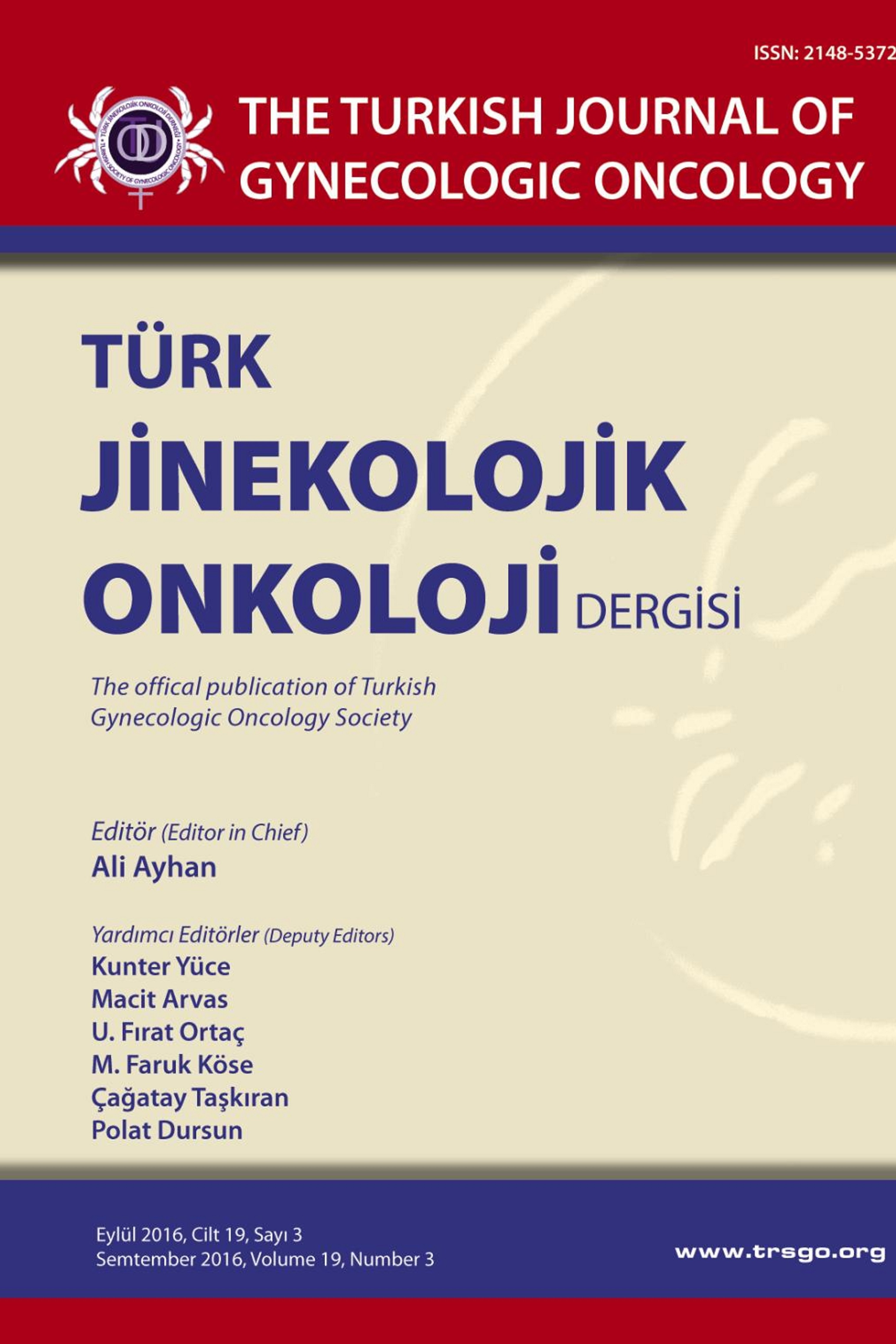RADİKAL JİNEKOLOJİK CERRAHİNİN ÜRİNER İNKONTİNANS’ A ETKİSİ
Jinekolojik cerrahi, inkontinans, lenf nodu diseksiyonu
THE EFFECT OF RADİCAL GYNECOLOGİC SURGERY ON URİNARY İNCONTİNENCE
: Gynecologic surgery, incontinence, lymphnode dissection,
___
- 1. T.C. Sağlık Bakanlığı. Türkiye’de Bölgelere ve Cinsiyete Göre Kanser Olguları, 2002 yılı verileri, www.saglik.gov.tr 2. T.C. Sağlık Bakanlığı. Türkiye Kanser İstatislikleri. M. Gültekin, G. Boztaş. Ocak 2014.
- 3. Carter J, Penson R, Barakat R, Wenzel L. Contemporary quality of life issues affecting gynecologic cancer survivors. HematolOncolClin North Am. 2012 Feb;26(1):169-94.
- 4. Abrams P, Cardozo L, Fall M, Griffiths D, RosierP,Ulmsten U. The standardization of terminology of lowe rurinary tract function: report from the standardization sub-committee of the International Continence Society. NeurourolUrodyn 2002; 21: 167 -178.
- 5. Kinchen KS, Burgio K, Diokno AC, Fultz NH, Bump R, Obenchain R. Factors associated with women’s decisions to seek treatment for urinary in continence. J Womens Health 2003; 12: 687-698
- 6. Hagglund D, Walker-Engstrom M-L, Larsson G, Leppert J. Reasons why women with long-term urinary incontinence do not seek Professional help: a cross-sectional populationbased cohort study. IntUrogynecol J 2003; 14: 296-304.
- 7. Herzog RA, Fultz NH, Normolle DP, et al. Methods used to manage of urinary incontinence in the elderly. Journal of theAmericanGeriatricsociety 37: 339-347, 1989.
- 8. Cam Ç, Sakalli M, Ay P,Cam M, Karateke A. Validation of the Short Forms of the Incontinence Impact Questionnaire (IIQ-7) and the UrogenitalDistress Inventory (UDI6) in a Turkish Population. NeurourologyandUrodynamics26:129-133 (2007)
- 9. Wyman JF, Harkins SW, Choi SC, Taylor JR, Fantl JA. Psychosocia limpact of urinary incontinence in women. ObstetGynecol. 1987 Sep; 70(3 Pt 1): 378- 81.
- 10. Uebersax, J.S.,Wyman, J. F., Shumaker, S. A., McClish, D. K., Fantl, J. A., & the Continence Program for Women Research Group. (1995). Short forms to assess life quality and symptom distress for urinary incontinence in women: The incontinence impact questionnaire and the urogenital distress inventory. NeurourologyandUrodynamics, 14, 131-139.
- 11. Gaudenz R. [A questionnaire with a new urge-scoreand stresss core for the evaluation of female urinary incontinence (author’stransl)] Geburt shilfe Frauenheilkd. 1979 Sep; 39(9): 784- 92. German
- 12. Ishiko O, Sumi T, Hirai K, Ogita S. Classification of female urinary incontinence by the scored incontinence questionnaire. Int J GynaecolObstet. 2000 Jun; 69(3): 255- 60.
- 13. Maral I, Özkardeş H, PeskircioğluL,Bumin MA. Prevalence of stres urinary incontinence in both sexes at or after age 15 years: a cross-sectional study. J Urol 2001; 165:408-412
- 14. Filiz TM, Uludağ C, Çınar N, Gorpelioğlu S, Topsever P. Risk factors for urinary incontinence in Turkish women. SaudiMed J 2006; 27(11):1688- 1692.
- 15. Buchsbaum GM, Chin M, Glantz C, Guzick D. Prevalence of urinary incontinence and associated risk factors in a cohort of nuns. ObstetGynecol 2002; 100:226-9
- 16. Simeonova Z, Milsom I, Kullendorff AM, Molander U, Bengtsson C. The prevalence of urinary incontinence and its influence on the quality of life in women from an urban Swedish population. Acta Obstet GynecolScand 1999; 78:546-51.
- 17. Johnson 2nd TM, Kincade JE, Bernard SL, Busby-Whitehead J, Hertz-Picciotto I, DeFriese GH. The association of urinary incontinence with poor self-rated health. JAmGeriatrSoc 1998;46(6):693–9.
- 18. Sensoy N, Dogan N, Ozek B, Karaaslan L. Urinary incontinence in women: prevalence rates, risk factors and impact on quality of life. Pak J Med Sci. 2013 May;29(3):818-22.
- 19. Lasserre, A., Pelat, C., Guéroult, V., Hanslik, T., ChartierKastler, E., Blanchon, T., ... & Bloch, J. (2009). Urinary incontinence in French women: prevalence, risk factors, and impact on quality of life. European urology, 56(1), 177-183.
- 20. Erekson EA, Sung VW, DiSilvestro PA, Myers DL. Urinary symptoms and impact on quality of life in women after treatment for endometrial cancer. IntUrogynecol J PelvicFloorDysfunct 2009;20(2):159–63.
- 21. Herwig R, Bruns F, Strasser H, et al. Late urologic effects after adjuvant irradiation in stage I endometrial carcinoma. Urology. 2004 Feb;63(2):354-8.
- 22. Nout RA, Putter H, Jü rgenliemk-Schulz IM, et al. Quality of life after pelvic radiotherapy or vaginal brachytherapy for endometrial cancer: first results of the randomized PORTEC-2 trial. J Clin Oncol. 2009 Jul 20;27(21):3547-56.
- 23. Nout RA, van de Poll-Franse LV, Lybeert ML, et al. Longterm outcome and quality of life of patients with endometrial carcinoma treated with or without pelvic radiotherapy in the post operative radiation therapy in endometrial carcinoma 1 (PORTEC-1) trial. J Clin Oncol. 2011 May 1;29(13):1692-700.
- 24. Rutledge T, Rogers R, Lee SJ, Muller CY. A pilot randomized control trial to evaluate pelvic floor muscle training for urinary incontinence among gynecologic cancer survivors. Gynecologic Oncology 132 (2014) 154–158.
- ISSN: 2148-5372
- Başlangıç: 2014
- Yayıncı: Türk Jinekolojik Onkoloji Derneği
İNVAZİV DUKTAL MEME KANSERİNDE GEÇ GENİTAL NÜKS: OLGU SUNUMU
Mehmet Hakan YETİMALAR, Aylin ORGEN ÇALLI
BORDERLİNE OVER TÜMÖRLERİ: TANI,TEDAVİ, TAKİP
RETROPERİTONEAL VASKÜLER VARYASYONLAR VE JİNEKOLOJİK ONKOLOJİ CERRAHİSİNDEKİ ÖNEMİ
Murat ÖZ, Salim ERKAYA, Bülent ÖZDAL, Mehmet Mutjlu MEYDANLI, İlker SELÇUK, Tayfun GÜNGÖR
Orhan ÜNAL, Önder SAKİN, Bülent KARS
RADİKAL JİNEKOLOJİK CERRAHİNİN ÜRİNER İNKONTİNANS’ A ETKİSİ
Tolgay Tuyan İLHAN, Ayşe Gül KEBAPÇILAR, Berat Berrin GENÇOĞLU, Türkan İLHAN, Tansel ÇAKIR, Çetin ÇELİK
Cem DANE, Hilal AŞIK, Selçuk ATALAY, Cansu BENLİ IŞIK
TUBANIN MALİGN MİKST MÜLLERİAN TÜMÖRÜ: MORFOLOJİK AÇIDAN FARKLI İKİ OLGU
Cem ÇOMUNOĞLU, Özlem ÖNEN, Kübra BOYNUKALIN, Cem BAYKAL, Ali AYHAN
BİR ÜNİVERSİTE HASTANESİNDE GESTASYONEL TROFOBLASTİK HASTALIK OLGULARININ DEĞERLENDİRİLMESİ
